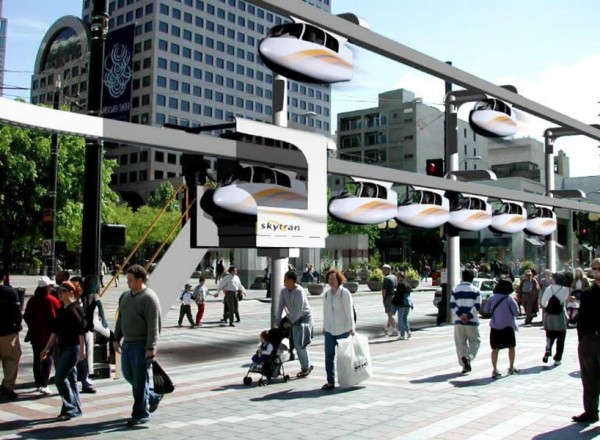Described by its developers as ‘the jetsons made into real life’, this innovative new system of personal rapid transit, designed by NASA and the private company Skytran, will make Tel Aviv the world’s first city to embrace this new system of mass transit.
The skytran “pods” have been designed following the concept of magnetic levitation (maglev), much like the MagLev trains in operation in East Asia.
Skytran would provide a greener, less expensive, faster (capable of reaching 241 km/h), and more comfortable alternative to cars and bus lines.
The pods must be requested via website or mobile app and they arrive almost instantly. After entering, having already inputted the desired location, you are brought directly to your destination.
Whereas creating or expanding existing underground subway networks is disruptive and expensive, skytran networks can be more easily implemented into cities along wide boulevards, suspended over the street.
This is not the only futuristic idea for reinventing transportation. ET3 (Evacuated Tube Transport Technologies) is another example of progressive inter-city transport innovations as well.
Are these futuristic innovations the next step in meeting Canadian cities’ transportation needs?
Via Design Boom
Urban Planet is a roundup of blogs from around the world dealing specifically with urban environments. For more stories from around the planet, check out Spacing on Facebook and Twitter.



4 comments
Personal Rapid Transit (PRT) schemes never go away, do they?
The pods need propulsion systems, as well as HVAC equipment to keep you from stifling in them. That won’t be light no matter how you do it. All those “stations with staircases” are, of course, non-accessible. OK for Tel Avivi I guess. Not going to work in North America.
Stops “a quarter mile” apart, or 400 m apart, will hardly solve the problem of transit dropping you off some distance from where you want to go–that’s about the spacing on the Yonge subway downtown.
Applying this to Toronto, the lightweight “stairs-only” stations will be overloaded at every stop downtown.
How do you deal with a breakdown? Passengers trapped in a pod twenty feet up in the air?
The promoter talks about putting on solar panels to make it energy-neutral. Sure, there goes the “little visual impact” aspect of this.
Whenever you see a transportation “innovation,” ask yourself “what would this look like if everyone used it?” The answer to that question will tell you whether it’s a glimpse of the future or a gimmick.
If everyone used this, the physical space requirements would be enormous. Plus all new infrastructure that presumably goes everywhere, and with maglev requirements, even more expensive than building roads. Even with computer control, the required follow distances at 200+km/h would be quite large, so it’s even less space efficient than a car, making it a non-starter for cities. If Tel Aviv is really rolling this out, expect it to hang around as a tourist attaction for a few decades, before eventually going the way of the Sydney Monorail.
If the above test was too complicated, you can circumvent. If the answer to any of the following three questions is “yes,” then it’s probably a gimmick.
Does the system resemble a monorail?
Can the system be described as PRT?
Do the words magnetic and levitation appear together anywhere in the marketing?
Don’t get me wrong, monorails and maglev are super cool, but the high costs and inability to piggy back on any existing infrastructure suggest that . PRT, on the other hand, is not super cool. However, some variations (not this one) can piggy back on existing infrastructure, so we might some day see a PRT system that is more than a gimmick.
Arghh. Must think in straight lines instead of jumping around all the time.
“…inability to piggy back on any existing infrastructure suggest that” they’ll never be mainstream transportation options.
Wuppertal/GER: Schwebebahn (suspended railway) – google it ;)